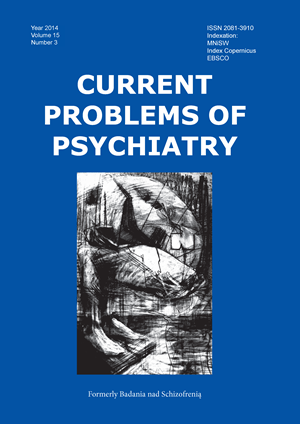The “Season of the Witch” and the honest message - the role of mass mediain the stigmatization of the mentally ill
Keywords:
stigmatization, schizophrenia, mediaAbstract
Stigmatization of people who have been diagnosed as having a mental illness is a very common phenomenon in the contemporary world, and it means psychiatric patients are labeled, often throughout their lives. This stigmatization often comes about though negative portrayal of the afflicted, in the mass media. This action, in turn, shapes negative attitudes inside the greater society, and it evokes prejudices towards the mentally ill. The media is full of exaggerated negative images of psychiatric patients, showing them as people extremely dangerous and unpredictable.
The article presents a review of the available literature concerning research conducted in Poland and in the world with respect to this phenomenon.
The first part of the article is a presentation of the role of the mass media in the stigmatization of people with mental disorders. In it, examples are given of newspaper articles and television programs that employ pejorative and stigmatizing terms. As put forward in our work, these are often unreliable portraits of the mentally ill that are created by people who have had no direct contact with the patients. According to the theory of cultivation of attitudes, as well as general social learning theory (both mentioned by Stout), the media have a huge impact on the perception and treatment of psychiatric patients. The media is full of imprecise names of diseases, and the term "schizophrenia" is often used as a metaphor or for the needs of the context. People with mental illness are, therefore, one of the most stigmatized social groups inside the general population, and this phenomenon increases the marginalization of their social role.
In the second part of the article, we try to show the mass media as being a potential tool for a change of attitudes from negative to positive among the general population, with respect to their attitudes towards the mentally ill. As discussed in the article, the sources of this stigma are deeply rooted in the culture and consciousness of the society at large. This positioning is understood as being dynamic and subject to the influences woven into the course of its development, with the influence of the mass media being one of the most conscious-building. This article highlights the need for supplying accurate information to the media, and the participation of psychiatrists and psychologists in creating programs dealing with problems of mental health.
References
1. Jarema M. Leksykon schizofrenii. Poznań; Termedia Wydawnictwa Medyczne: 2010.
2. Świtaj P. Doświadczanie piętna społecznego i dyskryminacji u pacjentów z rozpoznaniem schizofrenii. Warszawa; Instytut Psychiatrii i Neurologii: 2008.
3. Cechnicki A., Bielańska A., Franczyk J. Piętno choroby psychicznej: antycypacja I doświadczanie. Postępy Psychiatrii i Neurologii 2007; 16(2); 113-121.
4. Jackowska E. Stygmatyzacja i wykluczenie społeczne osób chorujących na schizofrenię – przegląd badań i mechanizmy psychologiczne. Psychiatria Polska. XLIII (6): 655-670.
5. Dziwota, E. (2014). Stygmatyzacja osób chorych psychicznie. Current Problems of Psychiatry, 15(1).
6. Boke, O., Aker, S., Aker, A. A., Sarisoy, G., & Sahin, A. R. (2007). Schizophrenia in Turkish newspapers. Social psychiatry and psychiatric epidemiology, 42(6), 457-461.
7. Grzywa A. Piętno choroby psychicznej. Psychiatria w Praktyce Ogólnolekarskiej. Via Medica: 2004; (4): 149-153
8. CBOS. Polacy wobec chorób psychicznych i osób chorych psychicznie. Komunikat z badań. Warszawa; 2005.
9. Duckworth, K., Halpern, J. H., Schutt, R. K., & Gillespie, C. (2003). Use of schizophrenia as a metaphor in US newspapers. Psychiatric Services, 54(10), 1402-1404.
10. Jarema M., Rabe-Jabłońska J. Psychiatria. Podręcznik dla studentów medycyny. Warszawa; PZWL: 2011.
11. Nairn, R. G., & Coverdale, J. H. (2005). People never see us living well: an appraisal of the personal stories about mental illness in a prospective print media sample. Australian and New Zealand Journal of Psychiatry, 39(4), 281-287.
12. Stout, P. A., Villegas, J., & Jennings, N. A. (2004). Images of Mental Illness in the Media. Schizophrenia Bulletin, 30(3), 543-561.
13. Gerbner, G., Gross, L., Morgan, M., & Signorielli, N. (1986). Living with television: The dynamics of the cultivation process. Perspectives on media effects, 17-40.
14. Bandura, A. (1977). Social learning theory.
15. Progler, Y. (2009). Mental illness and social stigma: notes on “How Mad Are You?”. Journal of research in medical sciences: the official journal of Isfahan University of Medical Sciences, 14(5), 331.
16. Angermeyer, M. C., Dietrich, S., Pott, D., & Matschinger, H. (2005). Media consumption and desire for social distance towards people with schizophrenia. European Psychiatry, 20(3), 246-250.
17. Angermeyer MC, Matschinger H. The effect of violent attacks by schizophrenic persons on the attitude towards individuals suffering from mental disorders. Social Psychiatry and Psychiatric Epidemiology 1996b; 31: 321-326.
18. Thys, E., Struyven, C. I., Danckaerts, M., & De Hert, M. (2014). EPA-0679-Stigmatization of schizophrenia in Flemish newspapers. European Psychiatry,29, 1.
19. Schulze, B. (2007). Stigma and mental health professionals: A review of the evidence on an intricate relationship*. International Review of Psychiatry, 19(2), 137-155.


